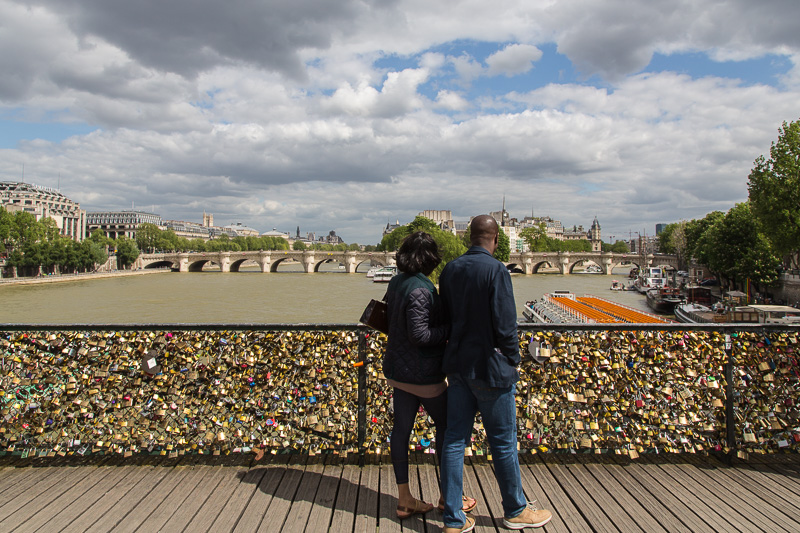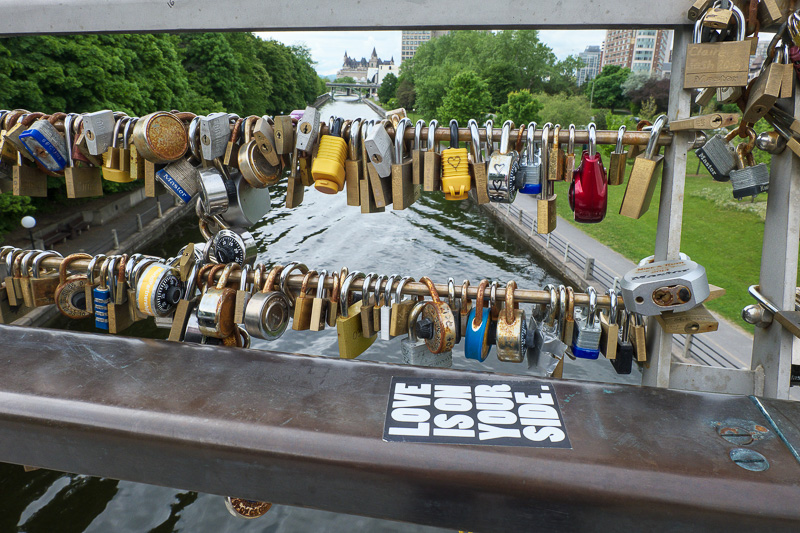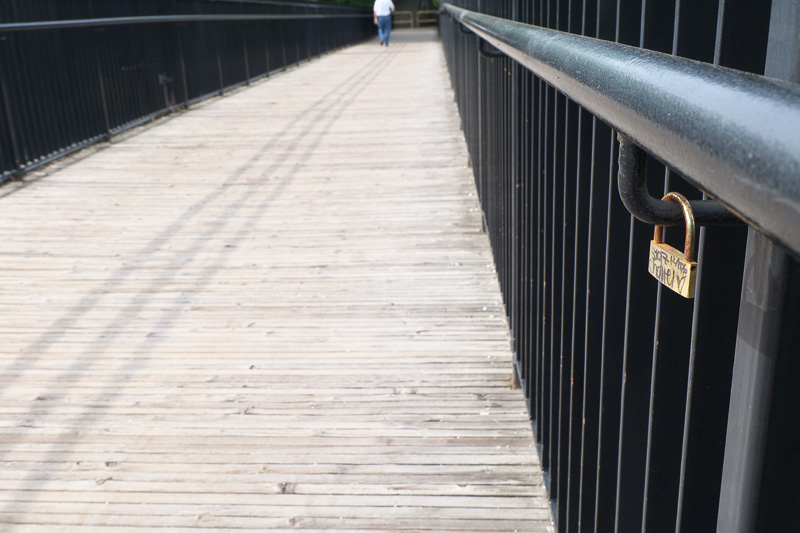
On Sunday evening a portion of the “Love-locks” bridge (Pont des Arts) in Paris collapsed. This is the pedestrian bridge that crosses the Seine connecting the Louvre museum to the St. Germain area. Lovers (locals? tourists? some of each? who knows?) have been inscribing their initials on locks and then fastening them to the sides of the bridge as a symbol of something-or-other. The weight of the locks has caused a portion of the bridge to buckle. Surely there is a metaphor in all of this.
Last spring, I crossed the Pont des Arts with the love of my life and, cynical rationalist that I am, I rolled my eyes and laughed at the (mostly teenage) lovers clicking their locks in place. Love may have been in the air, but there were bucket loads of hormones too.
The most surprising thing about this story (as I see it anyway) is the fact that the CBC cites Wikipedia as a credible news source. Yes, the journalistic worm has turned. But that observation belongs to a different post. The CBC cites Wikipedia’s list of other love-lock bridges around the world. By coincidence, I discovered one of those bridges last week while doing some street photography in Ottawa. There, I found the Corktown footbridge which crosses the Rideau Canal near the University of Ottawa. Compared to the Pont des Arts, it’s a fledgling love-lock bridge, but in a decade or so I can see the Corktown footbridge achieving international status as it topples into the Rideau.

Although Wikipedia doesn’t list it, Toronto has a love-lock bridge too. I don’t know the name of the bridge—it may not have a name—but it’s the wobbly footbridge that crosses Rosedale Valley and connects the loose ends of Glen Road. A plaque informs us that Morley Callaghan used to cross the bridge every day: “Neighbours saw and talked to him as he crossed this bridge with his wife and dog, Nikki, then with his dog, then alone until he died in 1990.” Even the Toronto Historical Board doesn’t seem to know the name of the bridge. It’s “this bridge.” No matter. Lovers have written their names on a lock and clicked it just below the railing. Meanwhile, cars roar underneath. Okay, there’s only one lock so far, but it’s a start. After all, there had to be a first lock on the Pont des Arts, no? I’ve simply documented that first lock for Toronto’s love-lock bridge. Given its wobbly disposition, and given its height above the valley floor, I suspect that turning Morley Callaghan’s footbridge into a love-lock bridge is a risky proposition.

Standing on the Corktown footbridge, I noted that some soul had pasted a sticker on the railing: Love is on your side. I don’t even know what that means. Does it mean anything? Is it intended to be romantic? Sentimental? Affirmative? Poetic? Deliberately puzzling? My eyes drifted across the array of locks. Two students were talking about locks that friends had placed there. I saw one lock with a laminate photo pasted to it, a wedding photo. Although the photo was small and I couldn’t be certain, it looked to me like a same-sex wedding photo. Another lock simply had a mustache on it. A joke? Then my eyes settled on another with a single word: nigger.

What the fuck is wrong with people? That was my first reaction. Why would someone want to taint the simple unaffected feelings that were in evidence everywhere on the bridge? And then I left, continuing alongside the canal, and reflecting on the lock that seemed to me a blight. As the afternoon proceeded, this is what I thought:
Except maybe for three-year-old children, there is no such thing as a simple unaffected feeling. We want our experience of love to match our sentimental yearnings. We want love to be on our side. We want our locks to hold. We want to click them to the railing and have them stay in place forever. But experience teaches us something different. Love doesn’t always hold. Or, if it does, it isn’t immutable. Sometimes it grows and strengthens. Sometimes it withers. Sometimes it transmogrifies into a beast that’s barely recognizable.
When I crossed the Pont des Arts with my wife, it was on a trip to mark a milestone in our marriage. I can’t remember if, at our wedding, someone read that piece from the first letter to the Corinthians, that piece about love. Probably. I’ve come to the conclusion that St. Paul was an idiot. Love isn’t patient and kind. Love is messy and dangerous. There is as much of darkness in love as there is of light. There have been times when I have hated my wife passionately. But hatred isn’t love’s opposite; hatred is sentimental love’s opposite. The two twine to form something else, something mature, something we probably don’t have a name for, not yet. But like Morley Callaghan’s bridge, the absence of a name makes it no less real.
The hatred that prompts a person to click a lock in place with the word nigger inscribed on its face is, I suspect, a shallow hatred, stuck there as a way of railing against the shallow love it sees all around it. The answer to shallow hatred isn’t to snip off the lock and to return the bridge to a state of pristine teenage love. The answer demands that we stare directly at the hatred and own it. The answer is to swallow the hatred whole, to subsume it within this larger love that I haven’t yet been able to name.
As I noted at the outset, there has to be a metaphor in here somewhere. I wonder about the recent EU vote and the unexpected turn to the hard right. It wasn’t enough to result in a dissolution of the EU, but it was enough to raise questions about its future and the future of a common currency. It also raises questions about rising nationalist sentiments and a corresponding shift in attitudes towards immigration. We can pretend these views don’t really exist; with a sentimental wave of nostalgia, we can hold to a vision of a unified Europe that manifests its destiny as a powerhouse of economic and moral progress. But this burden of sentiment, like the weight of sentimental love-locks, can bring the whole structure down.